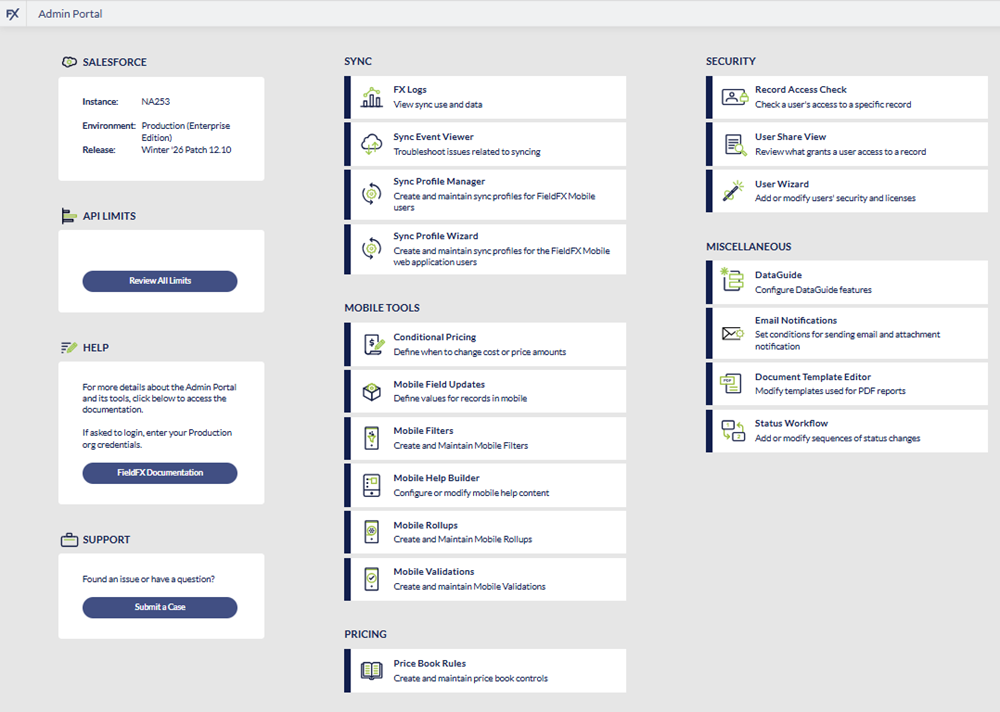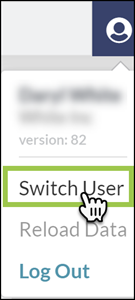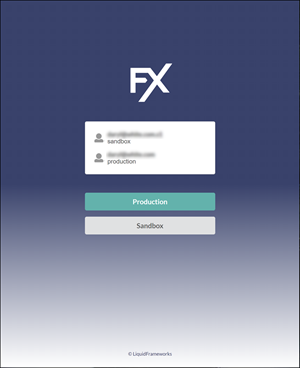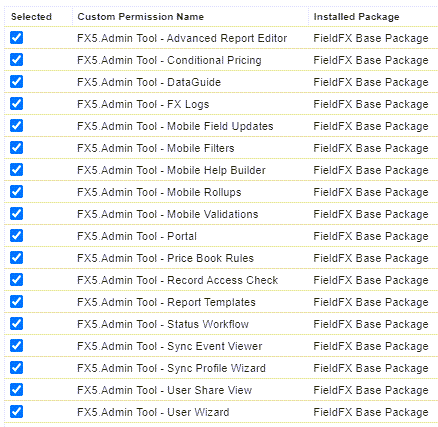Admin Portal Tools
Introduction
With the Admin Portal, system administrators can access user-friendly screens to manage various aspects of the FieldFX system. You can access functions such as user access, workflows, price book rules, and FX Logs viewers and Sync Events Viewers.

| The Admin Portal Dashboard is a responsive design. Depending on your device or browser tab size, the tool buttons might not be in the same place. |
|
You can’t access FX Logs from under the Sync block while you are in Back Office. You can access FX Logs in a separate tab.
|
| For version updates to the tools on the Admin Portal, see Admin Portal Updates. |
Prerequisites
These permission sets are required to |
|
||||||||||||||
To use the Admin Portal, the user profile must have one or more of these custom permissions: |
|
You will also need to set up access to the Admin Tools and Salesforce Tab Access.
Grant Access to Admin Tools
Anyone with the ability to edit or update your org’s Static Resource files can access the Admin Portal.
| You can only grant the Permission Sets or Profiles to users with a Salesforce license. |
-
From Setup, enter
Permission Setsin the Quick Find box, then select Permission Sets.Similar steps can be used for granting access through a Profile instead. Search for Profilesin Setup’s Quick Find box, then select Profiles. -
Click the permission set link for the Permission Set Label you need to modify.
-
Scroll to the bottom of the page and select System Permissions.
-
Click Edit Properties.
-
Mark the Enabled checkbox for Customize Application.
-
Click Save.
-
For other needed permission sets or profiles, repeat the above steps.
Step-by-Step Guides
Access the Admin Portal
| Inside of FieldFX Back Office, the Admin Dashboard accesses the FieldFX Admin Portal. |
Click to expand
-
Access the Admin Portal either by:
-
Open a browser tab to admin.fieldfx.com and log into the org with your system credentials.
-
In FieldFX Back Office,
-
Click on
 and type
and type admin. -
Select Admin Dashboard.
The Admin Dashboard tab appears along the top of the nav bar as the last item.
-
-
Click Add X Nav Item(s).
-
Move the newly added nav item by clicking on the item and dragging the move icon up or down on the list. If you want to add more items, repeat the steps above.
-
When in position, click Save.
A browser toast message appears that the nav item was added.
-
-
To save the Admin Dashboard tab as a permanent tab,
-
click
 to open the navigation items edit box.
to open the navigation items edit box.The name in the title differs depending on the FieldFX module you are in. If you switch FieldFX modules, the nav item won’t appear. Repeat these steps to add the Admin Dashboard tab to the FieldFX module you are in. -
Click Add More Items.
-
Click Available Items > All
-
Click Admin Dashboard.
A green check appears next to Admin Dashboard item and a "Admin Dashboard" pill appears below the search field. The number of items selected is also displayed.

-
|
Multiple Logins
The Admin Portal supports multiple logins, making it easy to manage changes across sandbox and production environments. Log in to multiple environments, then use Switch User to change which user is active.
Step by Step
-
Log in to the Admin Portal for an environment as normal.
-
From the Dashboard or any of the Admin Portal tools, select the user icon at the top right corner of the screen.

-
Select Switch User.

-
Select an existing user session to switch to or Select Production or Sandbox to add an additional log in and switch to that user.

Admin Portal Dashboard
| Depending on the user’s permissions, some options may not appear. The user must have these Custom Permissions to access the dashboard. |
The dashboard has these sections and links to the tools grouped in that section:
| Information Panels | Sync | Mobile Tools | Pricing Tools |
Security | Miscellaneous | Additional Tools |
|---|---|---|---|---|---|---|
Information Panels
The Admin Portal has information panels where you can review information about your Salesforce org and API Limits.
| Block | Description |
|---|---|
You can see the instance your org is on, whether it is on a production or sandbox environment, and what release your org is using. These fields are read-only and can’t be changed here. |
|
To see more details about your org’s API limits, click Review All Limits. |
|
To access the Admin Portal documentation. You will need your Production Org credentials, click FieldFX Documentation. |
|
Support |
To submit a support case to ServiceMax support, click Submit a Case. |
Sync
This section of the Admin Portal dashboard contains these tools:
| Tool | Description |
|---|---|
To display sync events, analyze slow syncs, and review sync errors, use FX Logs. |
|
With Sync Event Viewer, you can display sync event errors by user, modify sync events to correct errors, and preprocess modified events. To see the latest release notes, click this link. |
|
With Sync Profile Manager, is a redesign of the Sync Profile Wizard Admin Tool. In this tool,
|
|
With Sync Configuration Wizard, you can:
To see the latest release notes, click this link. |
Mobile Tools
In this section of the Admin Portal, Mobile Tools contain the following tools:
| Tool | Description |
|---|---|
|
|
|
|
|
|
|
|
|
|
|
Pricing Tools
| Tool | Description | ||
|---|---|---|---|
|
Security
| Tool | Description |
|---|---|
See what kind of permissions a user has to a particular record with the Record Access Check tool. |
|
|
|
|
Miscellaneous
This section contains these admin tools:
| Tool | Description | ||
|---|---|---|---|
This option is only present if the ServiceMax DataGuide is installed in the org and the individual user has the proper DataGuide permissions. If not, this option doesn’t appear. |
|||
|
|||
|
|||
|
Additional Tools
| Tool | Description |
|---|---|
|
|
|
|
|
|
|
